
Semestr2 / 1 - Oracle / Student_1-8
.pdf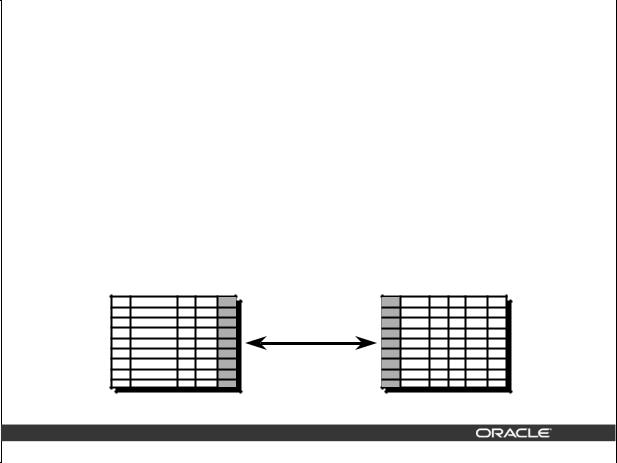
Capabilities of SQL SELECT Statements
Projection |
Selection |
||||||||||||
|
|
|
|
|
|
|
|
|
|
|
|
|
|
|
|
|
|
|
|
|
|
|
|
|
|
|
|
|
|
|
|
|
|
|
|
|
|
|
|
|
|
|
|
|
|
|
|
|
|
|
|
|
|
|
|
|
|
|
|
|
|
|
|
|
|
|
|
|
|
|
|
|
|
|
|
|
|
|
|
|
|
|
|
|
|
|
|
|
|
|
|
|
|
|
|
|
|
|
|
|
|
|
|
|
|
|
|
|
|
|
|
|
|
|
|
|
|
|
|
|
|
|
|
|
|
|
|
|
|
|
|
|
|
|
|
|
|
|
|
|
|
|
|
|
|
|
|
|
|
|
|
|
|
Table 1 |
Table 1 |
Join
Table 1 |
Table 2 |
1-3 |
Copyright © Oracle Corporation, 2001. All rights reserved. |
Capabilities of SQL SELECT Statements
A SELECT statement retrieves information from the database. Using a SELECT statement, you can do the following:
•Projection: You can use the projection capability in SQL to choose the columns in a table that you want returned by your query. You can choose as few or as many columns of the table as you require.
•Selection: You can use the selection capability in SQL to choose the rows in a table that you want returned by a query. You can use various criteria to restrict the rows that you see.
•Joining: You can use the join capability in SQL to bring together data that is stored in different tables by creating a link between them. You learn more about joins in a later lesson.
Introduction to Oracle9i: SQL Basics 1-3

Basic SELECT Statement
SELECT *|{[DISTINCT] column|expression [alias],...} FROM table;
•
•
SELECT identifies what columns
FROM identifies which table
1-4 |
Copyright © Oracle Corporation, 2001. All rights reserved. |
Basic SELECT Statement
In its simplest form, a SELECT statement must include the following:
•A SELECT clause, which specifies the columns to be displayed
•A FROM clause, which specifies the table containing the columns listed in the SELECT clause In the syntax:
SELECT |
is a list of one or more columns |
* |
selects all columns |
DISTINCT |
suppresses duplicates |
column|expression |
selects the named column or the expression |
alias |
gives selected columns different headings |
FROM table |
specifies the table containing the columns |
Note: Throughout this course, the words keyword, clause, and statement are used as follows:
•A keyword refers to an individual SQL element. For example, SELECT and FROM are keywords.
•A clause is a part of a SQL statement.
For example, SELECT employee_id, last_name, ... is a clause.
•A statement is a combination of two or more clauses.
For example, SELECT * FROM employees is a SQL statement.
Introduction to Oracle9i: SQL Basics 1-4
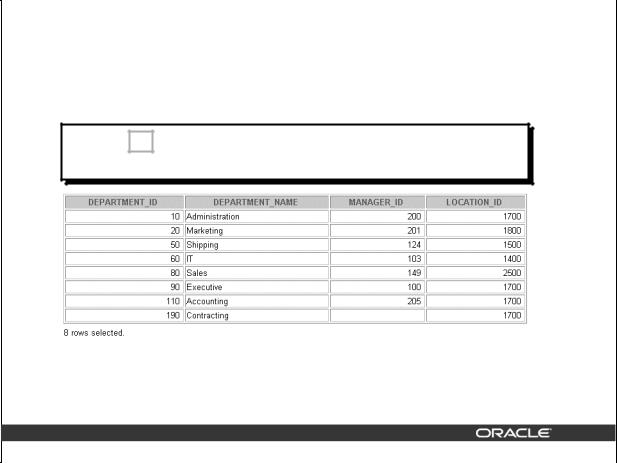
Selecting All Columns
SELECT *
FROM departments;
1-5 |
Copyright © Oracle Corporation, 2001. All rights reserved. |
Selecting All Columns of All Rows
You can display all columns of data in a table by following the SELECT keyword with an asterisk (*). In the example on the slide, the department table contains four columns: DEPARTMENT_ID, DEPARTMENT_NAME, MANAGER_ID, and LOCATION_ID. The table contains seven rows, one for each department.
You can also display all columns in the table by listing all the columns after the SELECT keyword. For example, the following SQL statement, like the example on the slide, displays all columns and all rows of the DEPARTMENTS table:
SELECT department_id, department_name, manager_id, location_id FROM departments;
Introduction to Oracle9i: SQL Basics 1-5
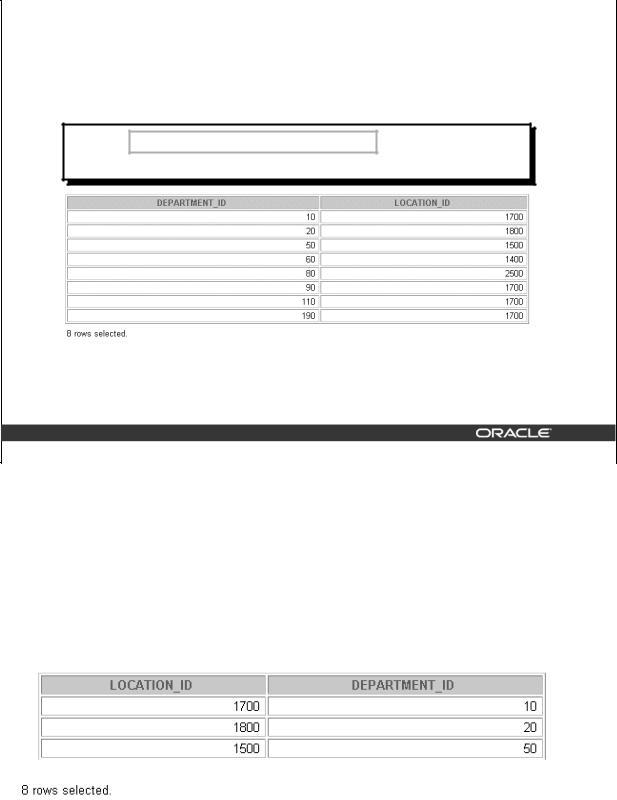
Selecting Specific Columns
SELECT department_id, location_id
FROM departments;
1-6 |
Copyright © Oracle Corporation, 2001. All rights reserved. |
Selecting Specific Columns of All Rows
You can use the SELECT statement to display specific columns of the table by specifying the column names, separated by commas. The example on the slide displays all the department numbers and location numbers from the DEPARTMENTS table.
In the SELECT clause, specify the columns that you want, in the order in which you want them to appear in the output. For example, to display location before department number going from left to right, you use the following statement:
SELECT location_id, department_id
FROM departments;
…
Introduction to Oracle9i: SQL Basics 1-6

Writing SQL Statements
•
•
•
•
•
SQL statements are not case sensitive.
SQL statements can be on one or more lines.
Keywords cannot be abbreviated or split across lines.
Clauses are usually placed on separate lines. Indents are used to enhance readability.
1-7 |
Copyright © Oracle Corporation, 2001. All rights reserved. |
Writing SQL Statements
Using the following simple rules and guidelines, you can construct valid statements that are both easy to read and easy to edit:
•SQL statements are not case sensitive, unless indicated.
•SQL statements can be entered on one or many lines.
•Keywords cannot be split across lines or abbreviated.
•Clauses are usually placed on separate lines for readability and ease of editing.
•Indents should be used to make code more readable.
•Keywords typically are entered in uppercase; all other words, such as table names and columns, are entered in lowercase.
Executing SQL Statements
Using iSQL*Plus, click the Execute button to run the command or commands in the editing window.
Introduction to Oracle9i: SQL Basics 1-7
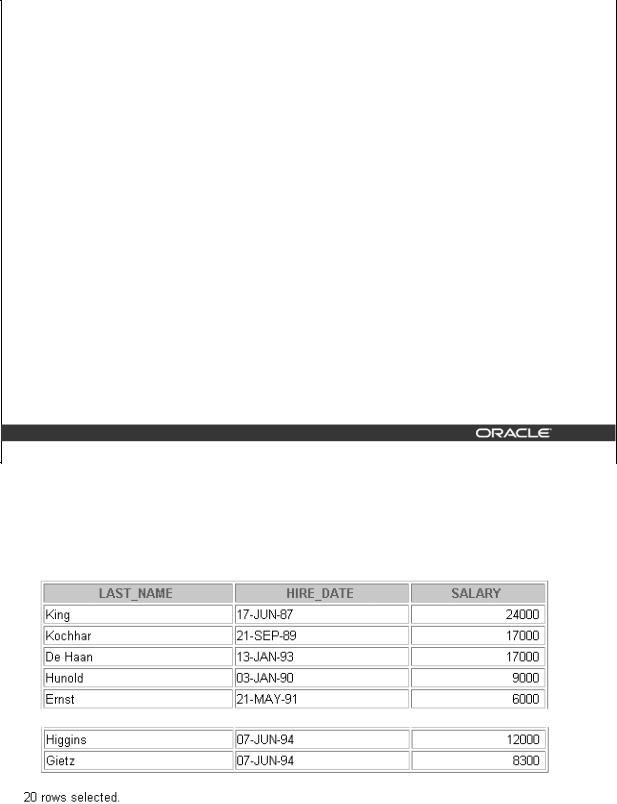
Column Heading Defaults
•iSQL*Plus:
–Default heading justification: Center
–Default heading display: Uppercase
•SQL*Plus:
–Character and Date column headings are leftjustified
–Number column headings are right-justified
–Default heading display: Uppercase
1-8 |
Copyright © Oracle Corporation, 2001. All rights reserved. |
Column Heading Defaults
In iSQL*Plus, column headings are displayed in uppercase and centered.
SELECT last_name, hire_date, salary
FROM employees;
…
You can override the column heading display with an alias. Column aliases are covered later in this lesson.
Introduction to Oracle9i: SQL Basics 1-8
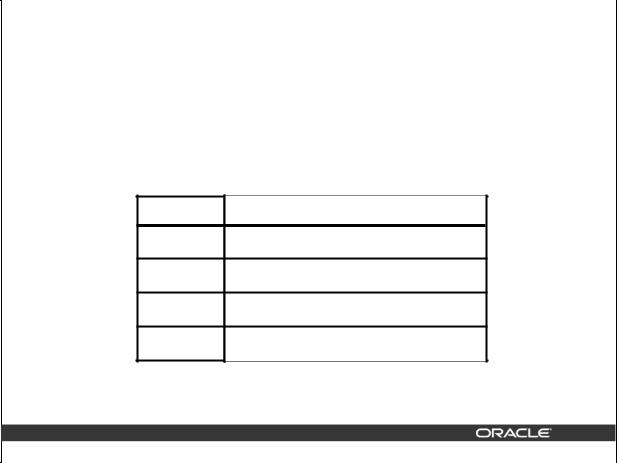
Arithmetic Expressions
Create expressions with number and date data by using arithmetic operators.
Operator Description
+Add
-Subtract
*Multiply
/Divide
1-9 |
Copyright © Oracle Corporation, 2001. All rights reserved. |
Arithmetic Expressions
You may need to modify the way in which data is displayed, perform calculations, or look at what-if scenarios. These are all possible using arithmetic expressions. An arithmetic expression can contain column names, constant numeric values, and the arithmetic operators.
Arithmetic Operators
The slide lists the arithmetic operators available in SQL. You can use arithmetic operators in any clause of a SQL statement except in the FROM clause.
Introduction to Oracle9i: SQL Basics 1-9
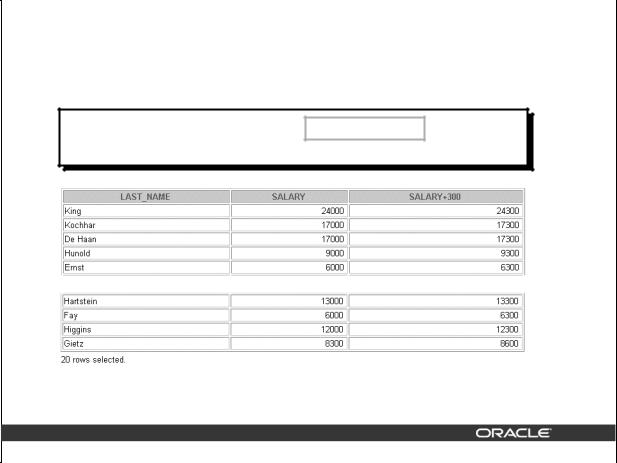
Using Arithmetic Operators
SELECT last_name, salary, salary + 300
FROM employees;
…
1-10 |
Copyright © Oracle Corporation, 2001. All rights reserved. |
Using Arithmetic Operators
The example in the slide uses the addition operator to calculate a salary increase of $300 for all employees and displays a new SALARY+300 column in the output.
Note that the resultant calculated column SALARY+300 is not a new column in the EMPLOYEES table; it is for display only. By default, the name of a new column comes from the calculation that generated it—in this case, salary+300.
Note: The Oracle9i server ignores blank spaces before and after the arithmetic operator.
Introduction to Oracle9i: SQL Basics 1-10
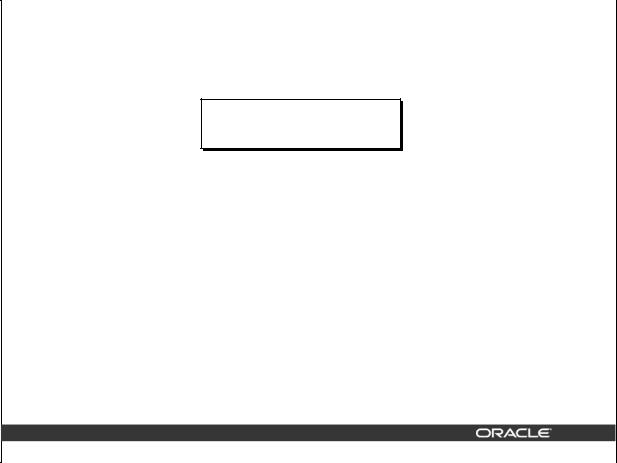
Operator Precedence
* / + _
•Multiplication and division take priority over addition and subtraction.
•Operators of the same priority are evaluated from left to right.
•Parentheses are used to force prioritized evaluation and to clarify statements.
1-11 |
Copyright © Oracle Corporation, 2001. All rights reserved. |
Operator Precedence
If an arithmetic expression contains more than one operator, multiplication and division are evaluated first. If operators within an expression are of same priority, then evaluation is done from left to right.
You can use parentheses to force the expression within parentheses to be evaluated first.
Introduction to Oracle9i: SQL Basics 1-11
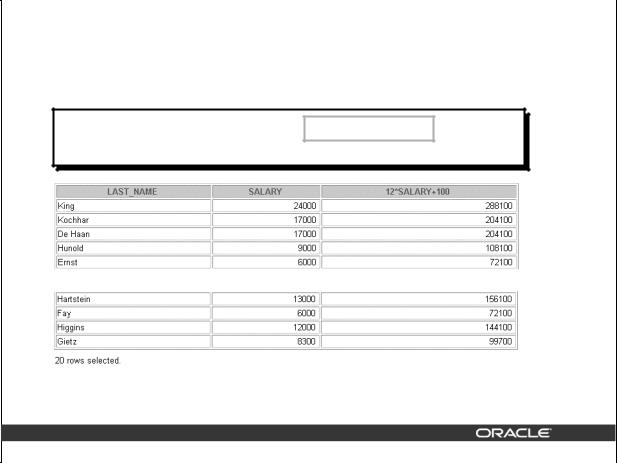
Operator Precedence
SELECT last_name, salary, 12*salary+100
FROM employees;
…
1-12 |
Copyright © Oracle Corporation, 2001. All rights reserved. |
Operator Precedence (continued)
The example on the slide displays the last name, salary, and annual compensation of employees. It calculates the annual compensation as 12 multiplied by the monthly salary, plus a one-time bonus of $100. Notice that multiplication is performed before addition.
Note: Use parentheses to reinforce the standard order of precedence and to improve clarity. For example, the expression on the slide can be written as (12*salary)+100 with no change in the result.
Introduction to Oracle9i: SQL Basics 1-12
